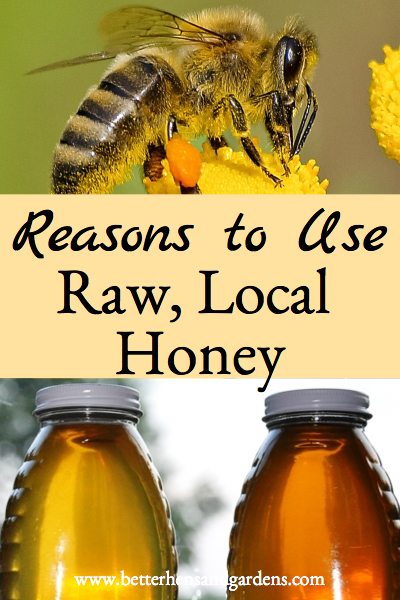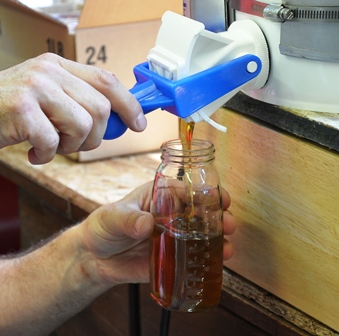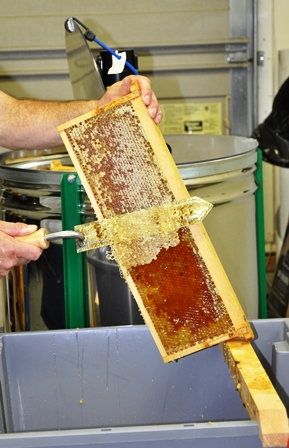When we think of vegetables, we know that raw, unprocessed vegetables have higher nutritional value than 
Why Raw Honey?
Raw honey is honey that hasn’t been heated or pasteurized, and it contains natural vitamins, enzymes, powerful antioxidants, and other important nutrients. Raw honey has anti-bacterial, anti-viral, and anti-fungal properties, and promotes digestive health.
Raw, local honey also contains a blend of local pollen, which can strengthen a person’s immune system, and reduce pollen allergy symptoms.
When honey is removed from the hive, it needs to be strained to remove parts of bee bodies and pieces of wax. If a coarse strainer is used without heating, then the honey will contain the pollen that was present in the original honey from the local area. If this local honey is ingested regularly, it can reduce pollen allergy symptoms in humans.
By supporting local honey producers, you can verify that the honey you’re purchasing is truly raw and has the beneficial properties that humans have used for centuries to treat many ailments.
What’s Not Raw Honey?
Most commercial honey; however, does not use the processing method described above. Instead, very fine filters are used along with heat to create pasteurized honey that no longer contains pollen but that has a long shelf life. This pasteurized, ultra-filtered honey does not have the nutritional benefits of raw honey.
In the U.S., the FDA says that any product that’s been ultra-filtered and no longer contains pollen isn’t honey. But, no ones checking U.S. honey to see if it contains pollen.
Ultra filtering is a procedure where honey is heated, sometimes watered down, and then forced at high pressure through extremely small filters to remove pollen (which is the only foolproof method of identifying the source of the honey). It’s a technique refined by the Chinese, who have illegally dumped tons of their honey (some containing illegal antibiotics and other substances such as heavy metals) on the U.S. market for years.
What’s the Difference Between Raw and Processed?
| EFFECT/DESCRIPTION | RAW HONEY | PROCESSED HONEY |
|---|---|---|
| Anti-Viral | ✔ | |
| Anti-Fungal | ✔ | |
| Anti-Bacterial | ✔ | |
| Anti-Carcinogenic | ✔ | |
| Anti-Inflammatory | ✔ | |
| Cough Suppressing | ✔ | ✔ |
| Blood Sugar Stabilizing | ✔ | |
| May Contain Antibiotics | ✔ |
|
| Clear Gold, Syrupy | ✔ | |
| Opaque, Cloudy, Viscous | ✔ | |
| Contains Beneficial Enzymes & Vitamins | ✔ | |
| Wound Healing | ✔ | |
| Free Radical Reducing | ✔ | |
| Decreases LDL Cholesterol | ✔ | |
| Contains Flavonoids & Phytonutrients | ✔ | |
| Contains Bee Pollen | ✔ | |
| Stabilizes Blood Pressure | ✔ | |
| Boosts Immunity | ✔ | |
| Promotes Digestive Health | ✔ |
Food Safety News decided to test honey sold in various outlets to find out whether it was truly honey. They purchased more than 60 jars, jugs and plastic bears of honey in 10 states and the District of Columbia. After having them analyzed, they found that:
- 76% of samples bought at groceries had all the pollen removed,
- 100% of the honey sampled from drugstores had no pollen.
- 77% of the honey sampled from big box stores had the pollen filtered out.
- 100% of the honey packaged in small individual portions had no pollen.
If it’s not honey, and it doesn’t have the nutritional benefits of honey – what’s the point of buying what’s in the stores? Local real honey will probably cost more, but at least you’ll know it has the health benefits of real honey. Support your local apiarist and honey bees! 

Richard Reikowski says
Nice work and information here! Mind if I share in on my webpage and blog?
Lesa says
Hi Richard, I’d be very happy if you’d share a link to it on your webpage and blog, but not copy it directly.
Matt says
Great article, very informative.
Hep Yo says
To be entirely clear (ha !), Raw honey is usually “translucent”. It will transmit light, but you cannot see objects help behind the bottle. “Opaque” means that no light gets through the honey whatsoever. It’s probably true that a super clear product that is entirely “transparent” like a wine glass, has been excessively filtered to improve consistency of appearance in commercial stores.
Jack Cahn MD says
The pollen that bees forage upon is generally from pollinator dependent plants, that is, they produce small amounts of pollen that must be carried by a vector from flower to flower. The pollens that cause most human allergies are produced in massive amounts by trees (oaks and pines for example), ragweed, and grasses. They produce so much pollen that it coats every outdoor surface. If you find these in honey it’s by accident. Humans are not allergic to poplars, locust, clover, maples, dandelions, goldenrod, apples, pecans, squash, etc., etc. There is no evidence that taking an allergen orally reduces one’s respiratory sensitivity. I believe that as responsible beekeepers we must stop promoting the myth that local honey helps allergies.
I am a beekeeper of 40 years and a family practice physician.
The best reason to buy local honey is to preserve the beekeepers in your locality whose bees are pollinating your local vegetables.
Lesa says
Well, as a responsible beekeeper, I have to say that consuming raw honey seems to have minimized my allergies and improved my respiratory health significantly.
Jeff says
I understand what Jack says, but have to agree with Lesa. I was quite skeptical about this actually. There are a lot of what I think are overblown claims about the health benefits of honey. However, since eating my honey every day my experience is similar to Lesa’s.
angie says
thanks for the useful information Here in southern Illinois it is fairly easy to find raw honey but it is still sold commercially in stores as well. Thanks again
come see us at http://shopannies.blogspot.com